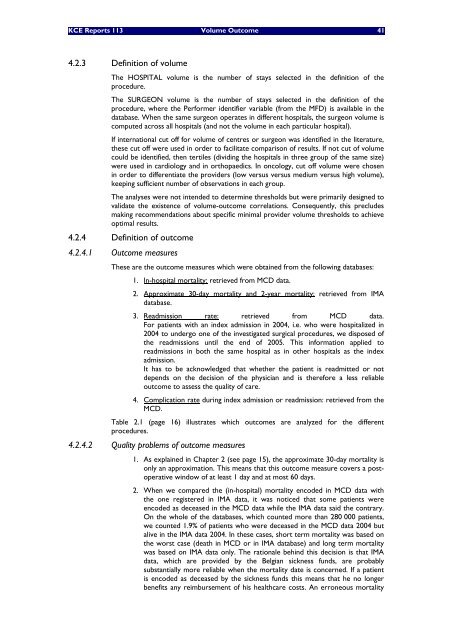Het volume van chirurgische ingrepen en de impact ervan op ... - KCE
Het volume van chirurgische ingrepen en de impact ervan op ... - KCE
Het volume van chirurgische ingrepen en de impact ervan op ... - KCE
You also want an ePaper? Increase the reach of your titles
YUMPU automatically turns print PDFs into web optimized ePapers that Google loves.
<strong>KCE</strong> Reports 113 Volume Outcome 41<br />
4.2.3 Definition of <strong>volume</strong><br />
The HOSPITAL <strong>volume</strong> is the number of stays selected in the <strong>de</strong>finition of the<br />
procedure.<br />
The SURGEON <strong>volume</strong> is the number of stays selected in the <strong>de</strong>finition of the<br />
procedure, where the Performer id<strong>en</strong>tifier variable (from the MFD) is available in the<br />
database. Wh<strong>en</strong> the same surgeon <strong>op</strong>erates in differ<strong>en</strong>t hospitals, the surgeon <strong>volume</strong> is<br />
computed across all hospitals (and not the <strong>volume</strong> in each particular hospital).<br />
If international cut off for <strong>volume</strong> of c<strong>en</strong>tres or surgeon was id<strong>en</strong>tified in the literature,<br />
these cut off were used in or<strong>de</strong>r to facilitate comparison of results. If not cut of <strong>volume</strong><br />
could be id<strong>en</strong>tified, th<strong>en</strong> tertiles (dividing the hospitals in three group of the same size)<br />
were used in cardiology and in orth<strong>op</strong>aedics. In oncology, cut off <strong>volume</strong> were chos<strong>en</strong><br />
in or<strong>de</strong>r to differ<strong>en</strong>tiate the provi<strong>de</strong>rs (low versus versus medium versus high <strong>volume</strong>),<br />
keeping suffici<strong>en</strong>t number of observations in each group.<br />
The analyses were not int<strong>en</strong><strong>de</strong>d to <strong>de</strong>termine thresholds but were primarily <strong>de</strong>signed to<br />
validate the exist<strong>en</strong>ce of <strong>volume</strong>-outcome correlations. Consequ<strong>en</strong>tly, this preclu<strong>de</strong>s<br />
making recomm<strong>en</strong>dations about specific minimal provi<strong>de</strong>r <strong>volume</strong> thresholds to achieve<br />
<strong>op</strong>timal results.<br />
4.2.4 Definition of outcome<br />
4.2.4.1 Outcome measures<br />
These are the outcome measures which were obtained from the following databases:<br />
1. In-hospital mortality: retrieved from MCD data.<br />
2. Approximate 30-day mortality and 2-year mortality: retrieved from IMA<br />
database.<br />
3. Readmission rate: retrieved from MCD data.<br />
For pati<strong>en</strong>ts with an in<strong>de</strong>x admission in 2004, i.e. who were hospitalized in<br />
2004 to un<strong>de</strong>rgo one of the investigated surgical procedures, we disposed of<br />
the readmissions until the <strong>en</strong>d of 2005. This information applied to<br />
readmissions in both the same hospital as in other hospitals as the in<strong>de</strong>x<br />
admission.<br />
It has to be acknowledged that whether the pati<strong>en</strong>t is readmitted or not<br />
<strong>de</strong>p<strong>en</strong>ds on the <strong>de</strong>cision of the physician and is therefore a less reliable<br />
outcome to assess the quality of care.<br />
4. Complication rate during in<strong>de</strong>x admission or readmission: retrieved from the<br />
MCD.<br />
Table 2.1 (page 16) illustrates which outcomes are analyzed for the differ<strong>en</strong>t<br />
procedures.<br />
4.2.4.2 Quality problems of outcome measures<br />
1. As explained in Chapter 2 (see page 15), the approximate 30-day mortality is<br />
only an approximation. This means that this outcome measure covers a post<strong>op</strong>erative<br />
window of at least 1 day and at most 60 days.<br />
2. Wh<strong>en</strong> we compared the (in-hospital) mortality <strong>en</strong>co<strong>de</strong>d in MCD data with<br />
the one registered in IMA data, it was noticed that some pati<strong>en</strong>ts were<br />
<strong>en</strong>co<strong>de</strong>d as <strong>de</strong>ceased in the MCD data while the IMA data said the contrary.<br />
On the whole of the databases, which counted more than 280 000 pati<strong>en</strong>ts,<br />
we counted 1.9% of pati<strong>en</strong>ts who were <strong>de</strong>ceased in the MCD data 2004 but<br />
alive in the IMA data 2004. In these cases, short term mortality was based on<br />
the worst case (<strong>de</strong>ath in MCD or in IMA database) and long term mortality<br />
was based on IMA data only. The rationale behind this <strong>de</strong>cision is that IMA<br />
data, which are provi<strong>de</strong>d by the Belgian sickness funds, are probably<br />
substantially more reliable wh<strong>en</strong> the mortality date is concerned. If a pati<strong>en</strong>t<br />
is <strong>en</strong>co<strong>de</strong>d as <strong>de</strong>ceased by the sickness funds this means that he no longer<br />
b<strong>en</strong>efits any reimbursem<strong>en</strong>t of his healthcare costs. An erroneous mortality

















